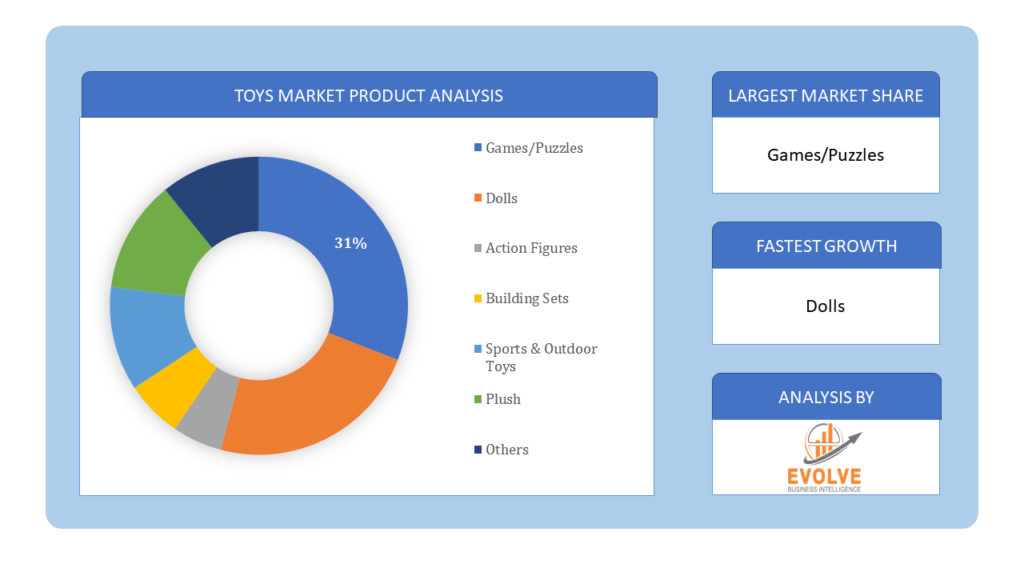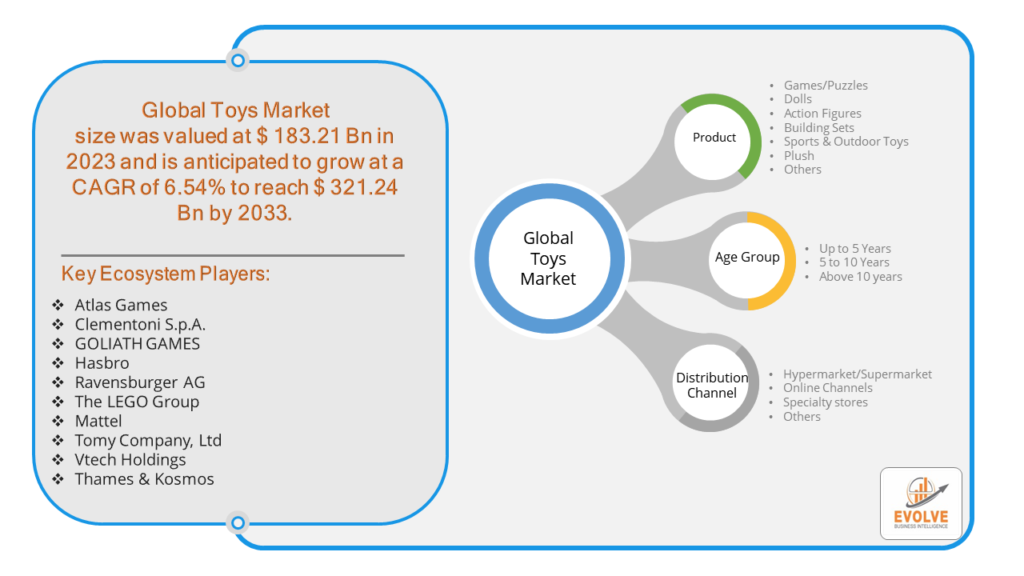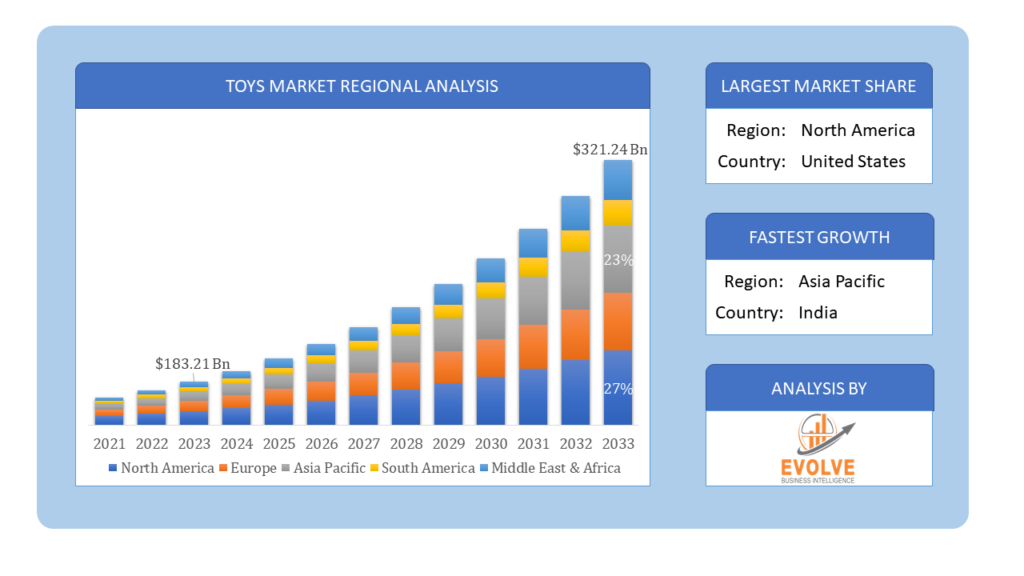Toys Market Analysis and Global Forecast 2023-2033
$ 1,390.00 – $ 5,520.00Price range: $ 1,390.00 through $ 5,520.00
Toys Market Research Report: Product (Games/Puzzles, Dolls, Action Figures, Building Sets, Sports & Outdoor Toys, Plush, Others), By Age Group (Up to 5 Years, 5 to 10 Years, Above 10 years) By Distribution Channel (Hypermarket/Supermarket, Online Channels, specialty stores and others), and by Region — Forecast till 2033
Page: 156
Toys Market Overview
The Toys Market Size is expected to reach USD 321.24 Billion by 2033. The Toys industry size accounted for USD 183.21 Billion in 2023 and is expected to expand at a compound annual growth rate (CAGR) of 6.54% from 2023 to 2033. The toys market encompasses the production, distribution, and sale of various playthings designed for entertainment and education across different age groups. It includes a wide range of products, from traditional toys like dolls and action figures to modern electronic gadgets and educational games. The market is influenced by trends, technology advancements, and cultural preferences, driving innovation and diversity in toy offerings. Major players in the industry include both global corporations and smaller, niche manufacturers, each competing to capture market share through product differentiation, branding, and marketing strategies. The toys market is also subject to regulations ensuring product safety and suitability for children.
Global Toys Market Synopsis
The COVID-19 pandemic has led to supply chain disruptions leading to supply shortages or lower demand in the Toys market. The travel restrictions and social-distancing measures have resulted in a sharp drop in consumer and business spending and this pattern is to continue for some time. The end-user trend and preferences have changed due to the pandemic and have resulted in manufacturers, developers, and service providers to adopt various strategies to stabilize the company.
Global Toys Market Dynamics
The major factors that have impacted the growth of Toys are as follows:
Drivers:
Technological Advancements
Rapid advancements in technology, particularly in areas like robotics, augmented reality (AR), and artificial intelligence (AI), are revolutionizing the toys industry. Tech-integrated toys offer interactive and immersive experiences, capturing the interest of both children and parents.
Restraint:
- Digital Disruption
The proliferation of digital entertainment options, including video games, mobile apps, and streaming services, poses a challenge to traditional toy sales. Children’s preferences are shifting towards digital experiences, reducing their interest in traditional toys. Toy manufacturers must adapt by incorporating digital elements into their products or developing complementary digital offerings to remain relevant in an increasingly digitalized world.
Opportunity:
⮚ Direct-to-Consumer (DTC) Channels
Direct-to-consumer (DTC) sales channels, including e-commerce platforms, company-owned stores, and subscription services, provide opportunities for toy manufacturers to bypass traditional retail channels and establish direct relationships with consumers. DTC strategies enable toy companies to control the end-to-end customer experience, gather valuable data insights, and cultivate brand loyalty through personalized marketing, exclusive offers, and customer engagement initiatives. Leveraging digital marketing, social media influencers, and user-generated content enhances visibility and drives online sales growth for DTC toy brands.
Toys Market Segment Overview
By Product
 Based on the Product, the market is segmented based on Games/Puzzles, Dolls, Action Figures, Building Sets, Sports & Outdoor Toys, Plush, Others. In the toys market, building sets and action figures dominate the product segment, reflecting a growing interest in construction-based play and imaginative storytelling. Games/puzzles also hold a significant market share, offering engaging and educational experiences for children of all ages.
Based on the Product, the market is segmented based on Games/Puzzles, Dolls, Action Figures, Building Sets, Sports & Outdoor Toys, Plush, Others. In the toys market, building sets and action figures dominate the product segment, reflecting a growing interest in construction-based play and imaginative storytelling. Games/puzzles also hold a significant market share, offering engaging and educational experiences for children of all ages.
By Age Group
Based on the Age Group,the market has been divided into Up to 5 Years, 5 to 10 Years, Above 10 years. In the toys market, the segment for children aged 5 to 10 years dominates, driven by a wide range of developmental needs and interests during this formative stage. The segment for children up to 5 years also holds significant market share, reflecting demand for toys that aid in early learning and sensory development.
By Distribution Channel
Based on Distribution Channel, the market has been divided into Hypermarket/Supermarket, Online Channels, specialty stores and others. In the toys market, online channels have emerged as the dominant segment, offering convenience, a wide product selection, and seamless shopping experiences. Specialty stores also play a significant role, providing personalized service and curated assortments, while hypermarkets/supermarkets cater to mass-market demand with their broad reach and competitive pricing strategies.
Global Toys Market Regional Analysis
Based on region, the market has been divided into North America, Europe, Asia-Pacific, the Middle East & Africa, and Latin America. The area of North America is anticipated to dominate the market for the usage of Toys, followed by those in Asia-Pacific and Europe.
 Toys North America Market
Toys North America Market
North America dominates the Toys market due to several factors. In North America, the toys market is characterized by its robust consumer base, driven by high disposable incomes and a strong culture of gifting and leisure spending. The region is home to several key players in the global toy industry, including established brands and innovative startups, contributing to a competitive marketplace. Shifts in consumer preferences towards educational and STEM-focused toys are influencing product development trends, with an emphasis on learning through play.
Toys Asia Pacific Market
The Asia-Pacific region has been witnessing remarkable growth in recent years. In the Asia-Pacific region, the toys market is experiencing rapid growth fueled by rising disposable incomes, urbanization, and expanding middle-class populations. Countries like China, Japan, and India are major contributors to the region’s toy industry, boasting large consumer markets and manufacturing capabilities. The market is characterized by a diverse range of toys catering to varied cultural preferences and traditions. Increasing digitalization and the adoption of technology-enhanced toys are driving innovation and shaping consumer demand.
Competitive Landscape
The competitive landscape includes key players (tier 1, tier 2, and local) having a presence across the globe. Companies such as Atlas Games, Clementoni S.p.A., GOLIATH GAMES, Hasbro, and Ravensburger AG are some of the leading players in the global Toys Industry. These players have adopted partnership, acquisition, expansion, and new product development, among others as their key strategies.
Key Market Players:
- Atlas Games
- Clementoni S.p.A.
- GOLIATH GAMES
- Hasbro
- Ravensburger AG
- The LEGO Group
- Mattel
- Tomy Company, Ltd
- Vtech Holdings
- Thames & Kosmos
Key development:
The Market undertakes a lot of developments under the leadership of its key companies to grow further. The key companies and producers of toys take up research and development to introduce new types of toys according to popular demand. Many companies create their niche with new product lines and a newly captured audience segment. Many companies undertake mergers, acquisitions, and collaborations to create better opportunities for Market Growth.
Scope of the Report
Global Toys Market, by Product
- Games/Puzzles
- Dolls
- Action Figures
- Building Sets
- Sports & Outdoor Toys
- Plush
- Others
Global Toys Market, by Age Group
- Up to 5 Years
- 5 to 10 Years
- Above 10 years
Global Toys Market, by Distribution Channel
- Hypermarket/Supermarket
- Online Channels
- Specialty stores
- Others
Global Toys Market, by Region
- North America
- US
- Canada
- Mexico
- Europe
- UK
- Germany
- France
- Italy
- Spain
- Benelux
- Nordic
- Rest of Europe
- Asia Pacific
- China
- Japan
- South Korea
- Indonesia
- Austalia
- Malaysia
- India
- Rest of Asia Pacific
- South America
- Brazil
- Argentina
- Rest of South America
- Middle East & Africa
- Saudi Arabia
- UAE
- Egypt
- South Africa
- Rest of Middle East & Africa
| Parameters | Indicators |
|---|---|
| Market Size | 2033: $321.24 Billion |
| CAGR | 6.54% CAGR (2023-2033) |
| Base year | 2022 |
| Forecast Period | 2023-2033 |
| Historical Data | 2021 |
| Report Coverage | Revenue Forecast, Competitive Landscape, Growth Factors, and Trends |
| Key Segmentations | Product, Age Group, Distribution Channel |
| Geographies Covered | North America, Europe, Asia-Pacific, Latin America, Middle East, Africa |
| Key Vendors | Atlas Games, Clementoni S.p.A., GOLIATH GAMES, Hasbro, Ravensburger AG, The LEGO Group, Mattel, Tomy Company, Ltd, Vtech Holdings, Thames & Kosmos |
| Key Market Opportunities | • Producers producing merchandise collectibles and old school toys in the future. |
| Key Market Drivers | • Increasing demand of multi-benefit toys |
REPORT CONTENT BRIEF:
- High-level analysis of the current and future Toys Industry trends and opportunities
- Detailed analysis of current market drivers, restraining factors, and opportunities analysis in the future
- Historical market size for the year 2021, and forecast from 2023 to 2033
- Toys market share analysis for each segment
- Competitor analysis with a comprehensive insight into its product segment, financial strength, and strategies adopted.
- Identifies key strategies adopted by the key players including new product development, mergers and acquisitions, joint ventures, collaborations, and partnerships.
- To identify and understand the various factors involved in the global Toys market affected by the pandemic
- To provide year-on-year growth from 2022 to 2033
- To provide short-term, long-term, and overall CAGR comparison from 2022 to 2033.
- Provide Total Addressable Market (TAM) for the Global Toys Market.
Press Release

Global Pharmaceutical Manufacturing Market to Reach $1.38 Trillion by 2035 with 7.35% CAGR, New Research Shows

The Global Mammography Market Is Estimated To Record a CAGR of Around 10.29% During The Forecast Period

Glue Stick Market to Reach USD 2.35 Billion by 2034

Podiatry Service Market to Reach USD 11.88 Billion by 2034

Microfluidics Technology Market to Reach USD 32.58 Billion by 2034

Ferric Chloride Market to Reach USD 10.65 Billion by 2034

Family Practice EMR Software Market to Reach USD 21.52 Billion by 2034

Electric Hairbrush Market to Reach USD 15.95 Billion by 2034

Daily Bamboo Products Market to Reach USD 143.52 Billion by 2034

Cross-border E-commerce Logistics Market to Reach USD 112.65 Billion by 2034
Frequently Asked Questions (FAQ)
1.What is the study period of this market?
- The study period of the global Toys market is 2022- 2033
2.What are the 10 Years CAGR (2023 to 2033) of the global Toys market?
- The global Toys market is growing at a CAGR of ~54% over the next 10 years
3.Which region has the highest growth rate in the market of Toys?
- Asia Pacific is expected to register the highest CAGR during 2023-2033
4.Which region accounted for the largest share of the market of Toys?
- North America holds the largest share in 2022
5.Major Key Players in the Market of Toys?
- Atlas Games, Clementoni S.p.A., GOLIATH GAMES, Hasbro, Ravensburger AG, The LEGO Group, Mattel, Tomy Company, Ltd, Vtech Holdings, Thames & Kosmos
Table of Content
CHAPTER 1. Executive Summary CHAPTER 2. Scope of the Study 2.1. Market Definition 2.2. Market Scope & Segmentation 2.2.1. Objective of Report CHAPTER 3. Evolve BI Methodology 3.1. Data Collection & Validation Approach 3.2. Market Size Estimation and Forecast CHAPTER 4. Exclusive Analysis 4.1. Market Opportunity Score 4.1.1. Product Segement – Market Opportunity Score 4.1.2. Age Group Segment – Market Opportunity Score 4.1.3. Distribution Channel Segment – Market Opportunity Score 4.2. Key Market Influencing Indicators CHAPTER 5. Market Insights and Trends 5.1. Value Chain Analysis 5.1.1. Raw Material 5.1.2. Manufacturing Process 5.1.3. Distribution Channel 5.1.4. End User 5.2. Porter’s Five Forces Analysis 5.2.1. Bargaining Power of Buyers 5.2.2. Bargaining Power of Suppliers 5.2.3. Threat of New Entrant 5.2.4. Threat of Substitute 5.2.5. Industry Rivalry 5.3. COVID-19 Impact and Post COVID Scenario on Toys Market 5.3.1. Impact of COVID-19 5.3.2. Government Support and Industry Revival Policies 5.3.3. Measures Taken by Companies to Mitigate Negative Impact 5.3.4. Post COVID Trend CHAPTER 6. MArket Dynamics 6.1. Introduction 6.2. Drivers 6.2.1. Driver 1 6.2.2. Driver 2 6.2.3. Driver 3 6.3. Restraints 6.3.1. Restraint 1 6.3.2. Restraint 2 6.4. Opportunity 6.4.1. Opportunity 1 CHAPTER 7. Global Toys Market, By Product 7.1. Introduction 7.1.1. Games/Puzzles 7.1.2. Dolls 7.1.3. Action Figures 7.1.4. Building Sets 7.1.5. Sports & Outdoor Toys 7.1.6. Plush 7.1.7. Others CHAPTER 8. Global Toys Market, By Age Group 8.1. Introduction 8.1.1. Up to 5 Years 8.1.2. 5 to 10 Years 8.1.3. Above 10 years CHAPTER 9. Global Toys Market, By Distribution Channel 9.1. Introduction 9.1.1. Hypermarket/Supermarket 9.1.2. Online Channels 9.1.3. Specialty stores 9.1.4. Others CHAPTER 10. Global Toys Market, By Region 10.1. Introduction 10.2. NORTH AMERICA 10.2.1. North America: Market Size and Forecast, By Country, 2023 – 2033 ($ Million) 10.2.2. North America: Market Size and Forecast, By Product, 2023 – 2033 ($ Million) 10.2.3. North America: Market Size and Forecast, By Age Group,2023 – 2033 ($ Million) 10.2.4. North America: Market Size and Forecast, By Distribution Channel, 2023 – 2033 ($ Million) 10.2.5. US 10.2.5.1. US: Market Size and Forecast, By Product, 2023 – 2033 ($ Million) 10.2.5.2. US: Market Size and Forecast, By Age Group,2023 – 2033 ($ Million) 10.2.5.3. US: Market Size and Forecast, By Distribution Channel, 2023 – 2033 ($ Million) 10.2.6. CANADA 10.2.6.1. Canada: Market Size and Forecast, By Product, 2023 – 2033 ($ Million) 10.2.6.2. Canada: Market Size and Forecast, By Age Group,2023 – 2033 ($ Million) 10.2.6.3. Canada: Market Size and Forecast, By Distribution Channel, 2023 – 2033 ($ Million) 10.2.7. MEXICO 10.2.7.1. Mexico: Market Size and Forecast, By Product, 2023 – 2033 ($ Million) 10.2.7.2. Mexico: Market Size and Forecast, By Age Group,2023 – 2033 ($ Million) 10.2.7.3. Mexico: Market Size and Forecast, By Distribution Channel, 2023 – 2033 ($ Million) 10.3. Europe 10.3.1. Europe: Market Size and Forecast, By Country, 2023 – 2033 ($ Million) 10.3.2. Europe: Market Size and Forecast, By Product, 2023 – 2033 ($ Million) 10.3.3. Europe: Market Size and Forecast, By Age Group,2023 – 2033 ($ Million) 10.3.4. Europe: Market Size and Forecast, By Distribution Channel, 2023 – 2033 ($ Million) 10.3.5. U.K. 10.3.5.1. U.K.: Market Size and Forecast, By Product, 2023 – 2033 ($ Million) 10.3.5.2. U.K.: Market Size and Forecast, By Age Group,2023 – 2033 ($ Million) 10.3.5.3. U.K.: Market Size and Forecast, By Distribution Channel, 2023 – 2033 ($ Million) 10.3.6. GERMANY 10.3.6.1. Germany: Market Size and Forecast, By Product, 2023 – 2033 ($ Million) 10.3.6.2. Germany: Market Size and Forecast, By Age Group,2023 – 2033 ($ Million) 10.3.6.3. Germany: Market Size and Forecast, By Distribution Channel, 2023 – 2033 ($ Million) 10.3.7. FRANCE 10.3.7.1. France: Market Size and Forecast, By Product, 2023 – 2033 ($ Million) 10.3.7.2. France: Market Size and Forecast, By Age Group,2023 – 2033 ($ Million) 10.3.7.3. France: Market Size and Forecast, By Distribution Channel, 2023 – 2033 ($ Million) 10.3.8. ITALY 10.3.8.1. Italy: Market Size and Forecast, By Product, 2023 – 2033 ($ Million) 10.3.8.2. Italy: Market Size and Forecast, By Age Group,2023 – 2033 ($ Million) 10.3.8.3. Italy: Market Size and Forecast, By Distribution Channel, 2023 – 2033 ($ Million) 10.3.9. SPAIN 10.3.9.1. Spain: Market Size and Forecast, By Product, 2023 – 2033 ($ Million) 10.3.9.2. Spain: Market Size and Forecast, By Age Group,2023 – 2033 ($ Million) 10.3.9.3. Spain: Market Size and Forecast, By Distribution Channel, 2023 – 2033 ($ Million) 10.3.10. BENELUX 10.3.10.1. BeNeLux: Market Size and Forecast, By Product, 2023 – 2033 ($ Million) 10.3.10.2. BeNeLux: Market Size and Forecast, By Age Group,2023 – 2033 ($ Million) 10.3.10.3. BeNeLux: Market Size and Forecast, By Distribution Channel, 2023 – 2033 ($ Million) 10.3.11. RUSSIA 10.3.11.1. Russia: Market Size and Forecast, By Product, 2023 – 2033 ($ Million) 10.3.11.2. Russia: Market Size and Forecast, By Age Group,2023 – 2033 ($ Million) 10.3.11.3. Russia: Market Size and Forecast, By Distribution Channel, 2023 – 2033 ($ Million) 10.3.12. REST OF EUROPE 10.3.12.1. Rest of Europe: Market Size and Forecast, By Product, 2023 – 2033 ($ Million) 10.3.12.2. Rest of Europe: Market Size and Forecast, By Age Group,2023 – 2033 ($ Million) 10.3.12.3. Rest of Europe: Market Size and Forecast, By Distribution Channel, 2023 – 2033 ($ Million) 10.4. Asia Pacific 10.4.1. Asia Pacific: Market Size and Forecast, By Country, 2023 – 2033 ($ Million) 10.4.2. Asia Pacific: Market Size and Forecast, By Product, 2023 – 2033 ($ Million) 10.4.3. Asia Pacific: Market Size and Forecast, By Age Group,2023 – 2033 ($ Million) 10.4.4. Asia Pacific: Market Size and Forecast, By Distribution Channel, 2023 – 2033 ($ Million) 10.4.5. CHINA 10.4.5.1. China: Market Size and Forecast, By Product, 2023 – 2033 ($ Million) 10.4.5.2. China: Market Size and Forecast, By Age Group,2023 – 2033 ($ Million) 10.4.5.3. China: Market Size and Forecast, By Distribution Channel, 2023 – 2033 ($ Million) 10.4.6. JAPAN 10.4.6.1. Japan: Market Size and Forecast, By Product, 2023 – 2033 ($ Million) 10.4.6.2. Japan: Market Size and Forecast, By Age Group,2023 – 2033 ($ Million) 10.4.6.3. Japan: Market Size and Forecast, By Distribution Channel, 2023 – 2033 ($ Million) 10.4.7. INDIA 10.4.7.1. India: Market Size and Forecast, By Product, 2023 – 2033 ($ Million) 10.4.7.2. India: Market Size and Forecast, By Age Group,2023 – 2033 ($ Million) 10.4.7.3. India: Market Size and Forecast, By Distribution Channel, 2023 – 2033 ($ Million) 10.4.8. SOUTH KOREA 10.4.8.1. South Korea: Market Size and Forecast, By Product, 2023 – 2033 ($ Million) 10.4.8.2. South Korea: Market Size and Forecast, By Age Group,2023 – 2033 ($ Million) 10.4.8.3. South Korea: Market Size and Forecast, By Distribution Channel, 2023 – 2033 ($ Million) 10.4.9. THAILAND 10.4.9.1. Thailand: Market Size and Forecast, By Product, 2023 – 2033 ($ Million) 10.4.9.2. Thailand: Market Size and Forecast, By Age Group,2023 – 2033 ($ Million) 10.4.9.3. Thailand: Market Size and Forecast, By Distribution Channel, 2023 – 2033 ($ Million) 10.4.10. INDONESIA 10.4.10.1. Indonesia: Market Size and Forecast, By Product, 2023 – 2033 ($ Million) 10.4.10.2. Indonesia: Market Size and Forecast, By Age Group,2023 – 2033 ($ Million) 10.4.10.3. Indonesia: Market Size and Forecast, By Distribution Channel, 2023 – 2033 ($ Million) 10.4.11. MALAYSIA 10.4.11.1. Malaysia: Market Size and Forecast, By Product, 2023 – 2033 ($ Million) 10.4.11.2. Malaysia: Market Size and Forecast, By Age Group,2023 – 2033 ($ Million) 10.4.11.3. Malaysia: Market Size and Forecast, By Distribution Channel, 2023 – 2033 ($ Million) 10.4.12. AUSTRALIA 10.4.12.1. Australia: Market Size and Forecast, By Product, 2023 – 2033 ($ Million) 10.4.12.2. Australia: Market Size and Forecast, By Age Group,2023 – 2033 ($ Million) 10.4.12.3. Australia: Market Size and Forecast, By Distribution Channel, 2023 – 2033 ($ Million) 10.4.13. REST FO ASIA PACIFIC 10.4.13.1. Rest fo Asia Pacific: Market Size and Forecast, By Product, 2023 – 2033 ($ Million) 10.4.13.2. Rest fo Asia Pacific: Market Size and Forecast, By Age Group,2023 – 2033 ($ Million) 10.4.13.3. Rest fo Asia Pacific: Market Size and Forecast, By Distribution Channel, 2023 – 2033 ($ Million) 10.5. South America 10.5.1. South America: Market Size and Forecast, By Country, 2023 – 2033 ($ Million) 10.5.2. South America: Market Size and Forecast, By Product, 2023 – 2033 ($ Million) 10.5.3. South America: Market Size and Forecast, By Age Group,2023 – 2033 ($ Million) 10.5.4. South America: Market Size and Forecast, By Distribution Channel, 2023 – 2033 ($ Million) 10.5.5. BRAZIL 10.5.5.1. Brazil: Market Size and Forecast, By Product, 2023 – 2033 ($ Million) 10.5.5.2. Brazil: Market Size and Forecast, By Age Group,2023 – 2033 ($ Million) 10.5.5.3. Brazil: Market Size and Forecast, By Distribution Channel, 2023 – 2033 ($ Million) 10.5.6. ARGENTINA 10.5.6.1. Argentina: Market Size and Forecast, By Product, 2023 – 2033 ($ Million) 10.5.6.2. Argentina: Market Size and Forecast, By Age Group,2023 – 2033 ($ Million) 10.5.6.3. Argentina: Market Size and Forecast, By Distribution Channel, 2023 – 2033 ($ Million) 10.5.7. REST OF SOUTH AMERICA 10.5.7.1. Rest of South America: Market Size and Forecast, By Product, 2023 – 2033 ($ Million) 10.5.7.2. Rest of South America: Market Size and Forecast, By Age Group,2023 – 2033 ($ Million) 10.5.7.3. Rest of South America: Market Size and Forecast, By Distribution Channel, 2023 – 2033 ($ Million) 10.6. Middle East & Africa 10.6.1. Middle East & Africa: Market Size and Forecast, By Country, 2023 – 2033 ($ Million) 10.6.2. Middle East & Africa: Market Size and Forecast, By Product, 2023 – 2033 ($ Million) 10.6.3. Middle East & Africa: Market Size and Forecast, By Age Group,2023 – 2033 ($ Million) 10.6.4. Middle East & Africa: Market Size and Forecast, By Distribution Channel, 2023 – 2033 ($ Million) 10.6.5. SAUDI ARABIA 10.6.5.1. Saudi Arabia: Market Size and Forecast, By Product, 2023 – 2033 ($ Million) 10.6.5.2. Saudi Arabia: Market Size and Forecast, By Age Group,2023 – 2033 ($ Million) 10.6.5.3. Saudi Arabia: Market Size and Forecast, By Distribution Channel, 2023 – 2033 ($ Million) 10.6.6. UAE 10.6.6.1. UAE: Market Size and Forecast, By Product, 2023 – 2033 ($ Million) 10.6.6.2. UAE: Market Size and Forecast, By Age Group,2023 – 2033 ($ Million) 10.6.6.3. UAE: Market Size and Forecast, By Distribution Channel, 2023 – 2033 ($ Million) 10.6.7. EGYPT 10.6.7.1. Egypt: Market Size and Forecast, By Product, 2023 – 2033 ($ Million) 10.6.7.2. Egypt: Market Size and Forecast, By Age Group,2023 – 2033 ($ Million) 10.6.7.3. Egypt: Market Size and Forecast, By Distribution Channel, 2023 – 2033 ($ Million) 10.6.8. SOUTH AFRICA 10.6.8.1. South Africa: Market Size and Forecast, By Product, 2023 – 2033 ($ Million) 10.6.8.2. South Africa: Market Size and Forecast, By Age Group,2023 – 2033 ($ Million) 10.6.8.3. South Africa: Market Size and Forecast, By Distribution Channel, 2023 – 2033 ($ Million) 10.6.9. REST OF MIDDLE EAST & AFRICA 10.6.9.1. Rest of Middle East & Africa: Market Size and Forecast, By Product, 2023 – 2033 ($ Million) 10.6.9.2. Rest of Middle East & Africa: Market Size and Forecast, By Age Group,2023 – 2033 ($ Million) 10.6.9.3. Rest of Middle East & Africa: Market Size and Forecast, By Distribution Channel, 2023 – 2033 ($ Million) CHAPTER 12. Competitive Landscape 12.1. Competitior Benchmarking 2023 12.2. Market Share Analysis 12.3. Key Developments Analysis By Top 5 Companies 12.4. Market Share Acquisition Strategies: Analysis of Key Approaches Employed by Top Players CHAPTER 13. Company Profiles 13.1. Atlas Games 13.1.1. Business Overview 13.1.2. Financial Analysis 13.1.2.1. Business Segment Revenue, 2020, 2021, 2022, $ Million 13.1.2.2. Geographic Revenue Mix, 2022 (% Share) 13.1.3. Product Portfolio 13.1.4. Recent Development and Strategies Adopted 13.1.5. SWOT Analysis 13.2. Clementoni S.p.A. 13.3. GOLIATH GAMES 13.4. Hasbro 13.5. Ravensburger AG 13.6. The LEGO Group 13.7. Mattel 13.8. Tomy Company, Ltd 13.9. Vtech Holdings 13.10. Genie AI Ltd
Connect to Analyst
Research Methodology









